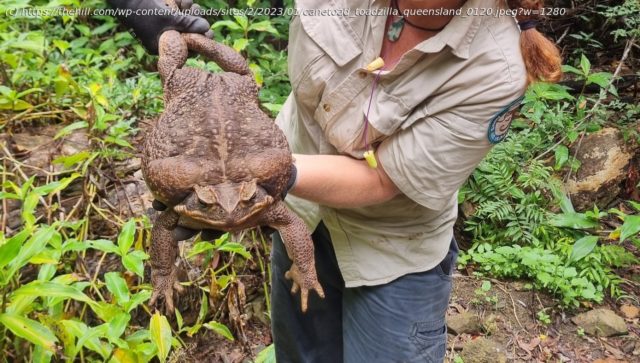Array
Rangers in an Australian national park have found and euthanized the largest toad on record.
Early attempts to name the 6-pound cane toad fizzled, park ranger Kylee Gray told Australian broadcasters, according to Reuters.
“We considered naming her Connie after Conway National Park, but Toadzilla was the one that just kept getting thrown out there, so that kind of stuck,” Gray said.
Toadzilla was the descendant of a botched experiment in wildlife management: the 1935 decision to import Central American cane toads to eat beetles in Australia’s sugarcane fields.
With no natural predators and plenty of other small species to eat, the poisonous toads ate the beetles — then set to work on the rest of the ecosystem.
“A female cane toad like potentially Toadzilla would lay up to 35,000 eggs. So their capacity to reproduce is quite staggering,” park ranger Barry Nolan told Reuters.
The Australian government and public now kill thousands of toads a year, according to the University of Sydney.
The most humane method of euthanasia is to stick frogs in a freezer until they nod off, the university reported.
Toadzilla’s body was donated to the Queensland National Museum, according to Reuters.
Welcome to Equilibrium, a newsletter that tracks the growing global battle over the future of sustainability. We’re Saul Elbein and Sharon Udasin. Not on the list? Subscribe here.
Today we’ll start by exploring why some veterans who long ago filed toxic exposure claims are now slamming the government for delaying their pursuit of justice.
Plus: The World Trade Organization calls for global carbon pricing, and a look at where future U.S. hydrogen hubs might take root.
Toxic exposure victims slam military, DOJ for delays
Thousands of Americans are waiting to seek justice for a historic set of toxic exposure claims, even though Congress removed barriers from pursuing such lawsuits months ago.
Not giving up: Some of those involved were shocked to see their cases, related to Marine Corps Base Camp Lejeune in North Carolina, dismissed last month over a technicality.
That technicality has required them to start the process over again.
But they don’t plan to give up the fight just yet.
Hope for survivors: “We sat in the gallery of the Senate three hours while the Senate voted on three different amendments and then took the final vote on the PACT Act,” said Mike Partain, a breast cancer survivor born at Camp Lejeune.
“Veterans were crying. They were hugging each other,” Partain added.
What’s the PACT Act? The Honoring our PACT Act is an expansive bill signed into law in August that improved benefits for veterans exposed to toxins.
Within the bill is a measure permitting lawsuits for those who endured on-base water contamination decades ago at Camp Lejeune.
The Congressional Budget Office has estimated that payouts to Camp Lejeune victims will amount to about $6.7 billion through 2031.
From elation to frustration: “I can’t explain how elated, how relieved I was that it finally passed,” Partain said.
But those feelings of elation have turned into frustration.
What happened? The same day that President Biden signed the bill into law, groups of plaintiffs filed multiple toxic exposure lawsuits against the U.S.
Just last month, however, Partain found out by chance — through a Google alert — that his case had been dismissed.
The reason for the dismissal, he learned, was a legal technicality: He needed to re-file what’s known as “an administrative claim” before filing his actual lawsuit.
Waiting game: “The law says you have to file an administrative claim with the Department of the Navy,” Partain said. “Our position was we already did.”
To read the rest of the story, please click here.
WTO chief calls for global carbon pricing
Adopting a global carbon pricing scheme could help streamline supply chains and mitigate concerns about competition, according to the head of the World Trade Organization (WTO).






